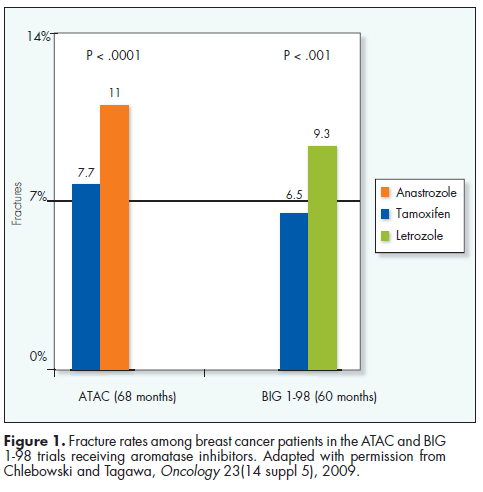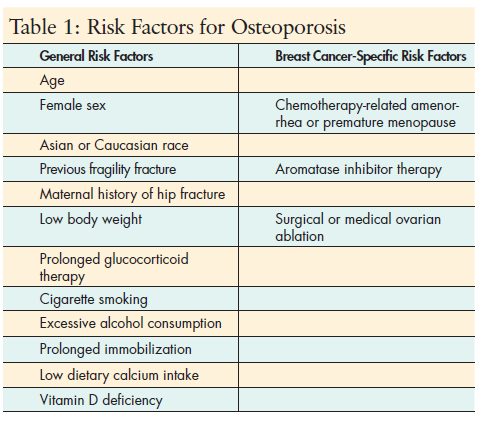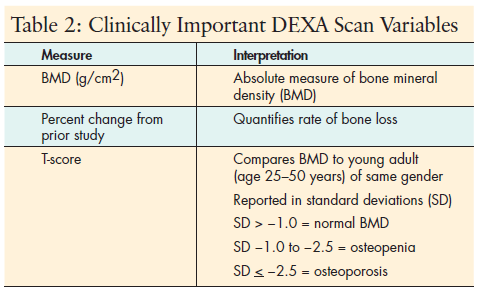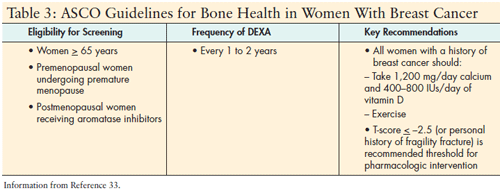Osteoporosis in a Young Breast Cancer Survivor
More than 2.5 million breast cancer survivors live in the US today.[1] This number will continue to grow thanks to early detection and advances in treatment that are making early stage breast cancer an increasingly curable disease.
More than 2.5 million breast cancer survivors live in the US today.[1] This number will continue to grow thanks to early detection and advances in treatment that are making early stage breast cancer an increasingly curable disease. None of these gains in survival, however, have come without cost, especially as treatment complexity increases. Long-term effects of treatment, which are complications that begin during treatment and continue beyond the end of treatment,[2] occur as a result of breast cancer therapies and are increasingly prevalent in breast cancer survivors.[3]
Younger women with breast cancer often receive very complex breast cancer treatment regimens, and thus are at risk for a host of various adverse effects. Nowadays, one in three women newly diagnosed with breast cancer is younger than 55 years of age. One of the most common side effects in women with breast cancer, including younger women, is cancer treatment–induced bone loss (CTIBL), which often leads to osteopenia and/or osteoporosis.
In the general US population, more than 8 million women have osteoporosis,[4] a condition characterized by decreased bone strength.[5] Vertebral, hip, and other bone fractures are the chief clinical manifestations of this disease.[6] A Caucasian woman's lifetime risk of osteoporotic fracture is as high as 45%,[7] with these fractures causing significant morbidity and substantial economic consequences.[8] Women with a breast cancer diagnosis are at increased risk for developing both osteoporosis and related fracture,[8,9] in large part due to the substantial role that estrogen plays in bone metabolism.

In women, estrogen protects against bone loss and reduces bone turnover[10] by decreasing the formation, activation, and lifespan of osteoclasts, the cells responsible for breaking down bone. As levels of estrogen decrease, whether due to natural or iatrogenic declines in ovarian function or other treatment effects, bone resorption exceeds new bone formation, leading to net bone loss.[11] Through a variety of mechanisms, treatments for breast cancer interfere with the positive effects of estrogen on bone metabolism, thereby inducing accelerated rates of bone loss.
CASE STUDY
In April 2004, a 45-year-old Caucasian premenopausal woman, “PM,” presented with a palpable right upper outer quadrant breast mass. Mammogram and ultrasound revealed a 1.8-cm hypoechoicc nodule in the right breast. Ultrasound-guided core biopsy revealed invasive ductal carcinoma, with positive estrogen receptors (ER+, 90% staining) and progesterone receptors (PR+, 70% staining). HER2/neu oncogene overexpression was negative (1+).

PM underwent a right breast lumpectomy and sentinel node biopsy. A 1.7-cm focus of invasive ductal cancer was excised, with clean margins, and three of five sentinel lymph nodes were positive. A subsequent axillary dissection removed 10 additional lymph nodes, of which 2 were involved by breast cancer. Thus, PM was diagnosed with stage IIA (T1N1M0) hormone receptor positive breast cancer.
PM's oncologist prescribed adjuvant chemotherapy with doxorubicin (Adriamycin) and cyclophosphamide (Cytoxan) (AC) chemotherapy every 2 weeks for a total of four cycles, followed by paclitaxel every 2 weeks for a total of four cycles. This treatment plan was followed by radiotherapy to the right breast and axillary lymph nodes. After two cycles of AC chemotherapy, PM stopped menstruating and developed hot flashes and night sweats. She returned to see her oncologist following radiotherapy, 3 months after chemotherapy ended, to discuss initiation of hormonal therapy. She still was not menstruating and continued to have hot flashes.
Because she was premenopausal at diagnosis, her oncologist prescribed tamoxifen at 20-mg daily, with a plan to switch to an aromatase inhibitor later if she became clearly postmenopausal. When she returned to the office a year later for routine follow-up, she was still not menstruating, and asked what implications this might have for her health. She was especially concerned because her mother had recently had a hip fracture after a long-standing history of osteoporosis, and she had heard that women with breast cancer are at higher risk of osteoporosis.
NURSING CARE
Given PM's premature menopause and other risk factors for osteoporosis, including family history of fracture and Caucasian race, her nurse practitioner (NP) orders a dual-energy X-ray absorptiometry (DEXA) scan to evaluate her bone mineral density (BMD). Test results from February 2006 show:
• BMD of the AP spine (L1–L4) = 0.977 g/cm2, T-score is −1.7 standard deviations (SD) below the mean for the young adult.
• BMD of the right femoral neck measures 0.942 (g/cm2); T-score is − 0.7 SD from the mean for the young adult.
• The FRAX tool shows PM's 10-year probability of any fracture is 5.7%, and is 0.2% for her 10-year probability of hip fracture (based on weight = 150 lbs, height = 64 inches, nonsmoker, maternal hip fracture).

PM is diagnosed as having osteopenia, and even though she has a family history of hip fracture, her 10-year risk of osteoporotic fracture does not meet the threshold for starting pharmacologic treatment. Following a discussion with her NP, she adds weight-training to her aerobic exercise regimen, and begins taking 600 mg of calcium and 400 IUs of vitamin D3 daily to supplement her daily glasses of milk.
Two years later, in February 2008, she meets with her oncologist to review her plan of treatment. She has never resumed menstrual periods since chemotherapy, is now 49 years old, and her follicle stimulating hormone (FSH) and estradiol levels show her to be in menopause. Her oncologist switches her to the aromatase inhibitor (AI) exemestane (Aromasin), and asks her to have a repeat DEXA scan to re-evaluate her BMD, as well as a test of her vitamin D level.
PM's vitamin D level is normal, and her DEXA scan again shows osteopenia of the lumbar spine, but it is essentially stable compared with the February 2006 study. Thus, she continues her current regimen of exercise and dietary supplementation with calcium and vitamin D.
Two years later, in February 2010, she remains on exemestane. She has a repeat DEXA scan, given the risk for CTIBL with AIs. The DEXA shows:
• BMD of AP spine L2–4 vertebrae measures 0.894 g/cm2, and PM's T-score = −2.5 SD from the mean for the young adult.
• BMD of the right femoral neck = 0.866 g/cm2, and PM's T-score =
−1.1 SD, for an interval change of
−5.8% from 2008.
• The FRAX tool shows PM's 10-year probability of any fracture is 9.3%, and is 0.3% for her 10-year probability of hip fracture.

PM now has osteoporosis of the spine and has had a significant drop in BMD in the past 2 years, which will likely continue while she is on exemestane. Even though her 10-year risk of osteoporotic fracture does not meet the threshold for pharmacologic therapy, her diagnosis of osteoporosis and her other risk factors are sufficient to require initiation of pharmacologic treatment.
She is given a prescription for alendronate (Fosamax) at a dosage of 70-mg weekly, with instructions on how to take this medication. (It should be taken on an empty stomach with approximately 8 ounces of water, and the patient should remain upright for 30 minutes after taking the pill.) Her nurse also instructs her to call should she require major dental work, given that withholding of alendronate may be recommended owing to the risk for osteonecrosis of the jaw with bisphosphonates.
PM will continue with her calcium and vitamin D supplementation and her exercise program, and she will have her next DEXA scan in 2 years. Her nursing team will continue to play a pivotal role in monitoring her bone health, promoting her adherence to medications and encouraging her to continue preventive strategies (such as exercise and adequate intake of calcium and vitamin D) that will help to improve the effectiveness of her bisphosphonate therapy.
DISCUSSIONChemotherapy-Induced Amenorrhea and Bone Loss
In premenopausal women diagnosed with breast cancer, the development of chemotherapy-related amenorrhea is the greatest risk factor for bone loss,[12–16] since it causes a marked and sudden reduction in circulating estradiol.[12] Premenopausal women who stop menstruating because of chemotherapy have reductions in BMD as high as 7.7% during the year following treatment[16,17]; this is more than seven times the annual rate of 1% observed in women with established menopause[6,10] and equivalent to reductions in BMD that occur following surgical oophorectomy.[18]
This bone loss occurs to a more rapid and substantial degree in the lumbar spine as opposed to the femoral neck.[13] The rate of bone loss decreases after the first 2 years, but bone loss still continues at a slower rate.[19]
Hormonal Therapy for Breast Cancer and Bone Loss

In premenopausal women, tamoxifen is associated with mild reductions in BMD of about 1.5% per year, but treatment with this agent does not cause bone loss in postmenopausal women.[13,20,21] In postmenopausal women, circulating estrogen levels are maintained by the activity of the aromatase enzyme, which converts adrenal androgens to estrogen.[22] Aromatase inhibitors interfere with this enzyme and decrease circulating levels of estrogens by 90%, precipitating bone loss.
Adjuvant use of AIs for 2 to 5 years is associated with both higher fracture rates[23–25] and greater bone loss[26–30] compared with tamoxifen or placebo (as high as 7.2% over 5 years on anastrozole). The risk of a major fracture is about 10% with 5 years of AI therapy (see Figure 1).[31] Ovarian ablation, which is presently being evaluated in large clinical trials to determine its role in the treatment of premenopausal women, causes substantial and rapid bone loss.[18,21]
Other Osteoporosis
Risk Factors
It is also important to consider general risk factors for osteoporosis (see Table 1) when evaluating and treating breast cancer survivors. These include nonmodifiable characteristics such as age and race, as well as external, modifiable factors such as health behaviors and medication exposures.[4] African Americans and Latinos have higher BMD than whites,[6] while low body weight, a personal history of fragility fracture, and a family history of fracture increase osteoporosis risk.[32]
Screening and Diagnosis of Osteoporosis
The gold standard test for screening and diagnosis of osteoporosis is the DEXA scan, a highly accurate X-ray technique that can measure BMD at any bony site.[6] BMD measurements of the hip and/or spine are preferred (see Table 2 for clinically important values), and include the absolute BMD, the percent change over time, and the T-score, which compares BMD to that of a healthy young adult (24–45 years) of the same sex. The American Society of Clinical Oncology (ASCO) guidelines for bone health in women with breast cancer recommend DEXA scans every 1 to 2 years in women at risk due to age, premature menopause, or hormonal therapy (see Table 3).[33] Most other national and international organizations recommend a 2-year interval between tests.[4,34] In general, the closer the BMD value is to the threshold at which treatment would be initiated, the sooner BMD testing should be repeated.[6]
Prevention and Treatment
The primary goal for both prevention and treatment of osteoporosis is preventing fracture.[4,35] National guidelines recommend lifestyle strategies for all women, including adequate calcium and vitamin D intake (see Table 3), avoidance of smoking or excessive alcohol intake, and either weight-bearing or muscle resistance training exercises.[33,36] Evidence is unclear as to whether supplementing to obtain certain threshold vitamin D levels, specifically 25-hydroxy vitamin D, is useful for promoting bone health,[31] but guidelines universally recommend vitamin D supplementation regardless of such monitoring.[33,37] ASCO guidelines recommend that pharmacologic treatment be initiated when the T-score falls at or below − 2.5 SD.[33]
Other national and international guidelines echo this recommendation[36] but now also integrate use of the FRAX tool, a validated model for predicting probability of fracture based on clinical risk factors in addition to BMD.[38] The FRAX tool is available online at http://www.shef.ac.uk/FRAX, and calculates the 10-year probability of hip fracture and any major osteoporotic fracture. In addition to the threshold T-score of − 2.5 SD or greater, the US-based National Osteoporosis Foundation recommends initiation of pharmacologic therapy when the 10-year probability of hip fracture is 3% and/or when the 10-year probability of any major osteoporotic fracture reaches 20%.[36] Table 4 provides dosage recommendations for vitamin D and calcium from the National Osteoporosis Foundation.[37]
Bone health and fracture prevention are clearly issues of increasing importance among breast cancer survivors. Optimal strategies to address the serious potential complication of osteoporosis in this population continue to evolve.
References:
References
1. Ries L, et al: SEER Cancer Statistics Review, 1975-2005 [cited May 15, 2008]. Available at: http://seer.cancer.gov/csr/1975_2005/. Accessed on March 20, 2010.
2. Hewitt M, Greenfield S, Stovall E: From Cancer Patient to Cancer Survivor: Lost in Transition. Washington, DC, The National Academies Press, 2006.
3. Partridge AH, Winer EP: Long-term complications of adjuvant chemotherapy for early stage breast cancer. Breast Dis 21:55-64, 2004.
4. World Health Organization: Prevention and Management of Osteoporosis: Report of a WHO Scientific Group. WHO Technical Report Series 2003. April 20, 2006. Available at: http://whqlibdoc.who.int/trs/WHO_TRS_921.pdf. Accessed on March 15, 2010.
5. Boonen S, et al: Effect of osteoporosis treatments on risk of non-vertebral fractures: Review and meta-analysis of intention-to-treat studies. Osteoporosis Int 16(10):1291â1298, 2005.
6. Cummings SR, Bates D, Black DM: Clinical use of bone densitometry: Scientific review. JAMA 288(15):1889â1897, 2002. [See erratum in JAMA 288(22):2825, 2002.]
7. Bringhurst FR, et al: Bone and Mineral Metabolism in Health and Disease, in Kasper DL, et al (eds): Harrison's Internal Medicine. New York, McGraw-Hill, 2005.
8. Theriault R, et al: NCCN Task Force Report: Bone Health and Cancer Care. J Nat Comp Cancer Network 4(suppl 2):S1âS20, 2006.
9. Winer EP, et al: Use of Aromatase Inhibitors As Adjuvant Therapy for Postmenopausal Women With Hormone Receptor-Positive Breast Cancer: Status Report 2004. Available at: http://www.asco.org/ac/1,1003,_12-002033-00_18-0036744-00_19-0036745-00_20-001,00.asp.
10. Love RR, et al: Effects of tamoxifen on bone mineral density bone mineral density in post-menopausal women with breast cancer. N Engl J Med 326:852â856, 1992.
11. Ahlborg HG, et al: Bone loss and bone size after menopause [See comment].N Engl J Med 349(4):327â334, 2003.
12. Saarto T, et al: Chemical castration induced by adjuvant cyclophosphamide, methotrexate, and fluorouracil chemotherapy causes rapid bone loss that is reduced by clodronate: A randomized study in premenopausal breast cancer patients. J Clin Oncol 15(4):1341â1347, 1997.
13. Vehmanen L, et al: Tamoxifen treatment after adjuvant chemotherapy has opposite effects on bone mineral density in premenopausal patients depending on menstrual status. J Clin Oncol 24(4):675â680, 2006.
14. Brunin PF, et al: Bone mineral density after adjuvant chemotherapy for premenopausal breast cancer. Brit J Cancer 61(2): 308â310, 1990.
15. Vehmanen L, et al: Short-term intermittent intravenous clodronate in the prevention of bone loss related to chemotherapy-induced ovarian failure. Breast Ca Res Treat 87(2):181â188, 2004.
16. Shapiro CL, Manola J, Leboff M: Ovarian failure after adjuvant chemotherapy is associated with rapid bone loss in women with early-stage breast cancer [see comment]. J Clin Oncol 19(14):3306â3311, 2001.
17. Saarto T, et al: Chemical castration induced by adjuvant cyclophosphamide, methotrexate, and fluorouracil chemotherapy causes rapid bone loss that is reduced by clodronate: A randomized study in premenopausal breast cancer patients.
J Clin Oncol 15(4):1341â1347, 1997.
18. Genant HK, et al: Quantitative computed tomography of vertebral spongiosa: A sensitive method for detecting early bone loss after oophorectomy. Ann Intern Med 97(5):699â705, 1982.
19. Vehmanen L, et al: Long-term impact of chemotherapy-induced ovarian failure on bone mineral density (BMD) in premenopausal breast cancer patients. The effect of adjuvant clodronate treatment. Eur J Cancer 37(18):2373â2378, 2001.
20. Fisher B, et al: Tamoxifen for prevention of breast cancer: Report of the National Surgical Adjuvant Breast and Bowel Project P-1 Study [see comment]. J Natl Cancer Inst 90(18):1371â1388, 1998.
21. Sverrisdottir A, et al: Bone mineral density among premenopausal women with early breast cancer in a randomized trial of adjuvant endocrine therapy. J Clin Oncol 22(18):3694â3699, 2004.
22. Eastell R, Hannon R: Long-term effects of aromatase inhibitors on bone. J Steroid Biochem Molec Biol 95(1-5):151â154, 2005.
23. Baum M, et al: Anastrozole alone or in combination with tamoxifen versus tamoxifen alone for adjuvant treatment of postmenopausal women with early-stage breast cancer: Results of the ATAC (Arimidex, Tamoxifen Alone or in Combination) trial efficacy and safety update analyses. Cancer 98(9):1802â1810, 2003.
24. Coombes RC, et al: A randomized trial of exemestane after two to three years of tamoxifen therapy in postmenopausal women with primary breast cancer.
N Engl J Med 350(11):1081â1092, 2004.
25. Goss PE, et al: A randomized trial of letrozole in postmenopausal women after five years of tamoxifen therapy for early-stage breast cancer. N Engl J Med 349(19):1793â1802, 2003.
26. Perez EA, et al: Effect of letrozole versus placebo on bone mineral density in women completing >5 years of adjuvant tamoxifen: NCIC CTG MA-17B. Breast Ca Res Treat 88(Suppl 1):S36, 2004.
27. Lonning PE, et al: Effects of exemestane administered for 2 years versus placebo on bone mineral density, bone biomarkers, and plasma lipids in patients with surgically resected early breast cancer [see comment]. J Clin Oncol 23(22):5126â5137, 2005.
28. Howell A: Effect of anastrozole on bone mineral density: 2-year results of the ‘Arimidex' (anastrozole), tamoxifen, alone or in combination (ATAC) trial. Breast Ca Res Treat 82(suppl 1):S27, 2003.
29. Coleman RE, et al: Intergroup Exemestane Study: 1 year results of the bone subprotocol, in 27th Annual San Antonio Breast Cancer Symposium. Breast Ca Res Treat 88:S35, 2004.
30. Eastell R, et al: Effect of anastrozole on bone mineral density: 5-year results from the anastrozole, tamoxifen, alone or in combination trial 18233230.
J Clin Oncol 26(7):1051â1057, 2008.
31. Chlebowski RT, Tagawa T: Early breast and prostate cancer and clinical outcomes (fracture). Oncology (Williston Park) 23(14, suppl 5):16â20, 2009.
32. Hamdy RC, et al: Review of treatment modalities for postmenopausal osteoporosis. South Med J 98(10):1000â1014, 2005.
33. Hillner BE, et al: American Society of Clinical Oncology 2003 update on the role of bisphosphonates and bone health issues in women with breast cancer. J Clin Oncol 21(21):4042â4057, 2003. [See erratum in J Clin Oncol 22(7):1351, 2004.]
34. U.S.P.S.T.F.: Screening for osteoporosis in postmenopausal women: Recommendations and rationale. Ann Intern Med 137(6):526â528, 2002.
35. Lindsay R, Cosman F: Osteoporosis, in Kasper DL, et al (eds): Harrison's Internal Medicine. New York, McGraw-Hill, 2005, pp 2268â2278.
36. National Osteoporosis Foundation: NOF Physician's Guidelines, 2008. Available at: http://www.nof.org/professionals/clinical.htm. Accessed on March 20, 2010.
37. National Osteoporosis Foundation: Calcium and Vitamin D Recommendations, 2008. Recommended calcium intakes. Available at: http://www.nof.org/prevention/calcium.htm. Accessed on March 20, 2010.
38. Kanis JA, et al: The use of clinical risk factors enhances the performance of BMD in the prediction of hip and osteoporotic fractures in men and women. Osteoporosis Int 18(8):1033â1046, 2007.